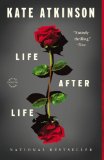Summary | Excerpt | Reading Guide | Reviews | Beyond the book | Read-Alikes | Genres & Themes | Author Bio

As a fan of Kate Atkinson's inventive fiction, I should have known what I was getting myself into when I tackled reviewing her latest novel, Life After Life. Yes, the book exceeds the five hundred-page mark and thus requires a certain commitment, but the long and sometimes exhausting mental journey springs primarily from Atkinson's cleverness in using unconventional structure to her advantage – the pathway of the repeated lives of protagonist Ursula Todd.
Ursula, the story's unlikely heroine, is born and then dies…and then is born again in February 1910. She enters the world for the first time stillborn, but survives her birth in the very next chapter due to a slight change in chronology and weather – a doctor makes it through a snowstorm just in time in the second version. And so goes the entire book and Ursula's many and varied lives. She is a literary character seemingly invented just to illustrate, if not answer, one of the oldest and most potentially regret-inducing questions of all time: What if I could live my life all over again?
The permutations of Ursula span both World Wars and are influenced by the influencers of her family, particularly her siblings. In every version of her life, her banker father, Hugh, and her inscrutable full time mother, Sylvie, raise Ursula comfortably in rural England. The intricacies of the Todd family life are just as important in the overall narrative as Ursula's unusual deja vu. As she has in past works, Atkinson spends a great deal of time exploring domestic relationships, the mysteries and vagaries of marriage, the intimacy and terror that sibling relationships can produce. Indeed, it is Ursula's love for her family that often brings on the uneasy premonitions that motivate her to try to change the future – or is it the past?
Reviewing with a divided mind is not easy. Do I say that the writing here is of the highest quality, that the settings are vivid? Yes. That even the complex structure and repetition serve a purpose? Yes, again. But will I also be transparent enough to say that the story wearied me, that it began to overwhelm? I must. The inevitable comparisons to a certain Bill Murray film may explain some of my mixed feelings. After all, the same person repeating the living of daily life in the same time and general geography eventually boggles the mind.
Yet I sense my discomfort is rooted somewhere deeper, perhaps in the very intent of Atkinson's literary experiment. I, like many members of the human race, am prone to much pondering of the "what ifs", "should haves", and "could haves." This novel simultaneously encourages and discourages these mental gymnastics. Ursula's ability to live life over and over affords her the opportunity of all my hindsighted daydreams. She is given the chance to alter the smallest details, such as saving a favorite childhood toy from a spiteful brother, as well as world history, seen in the opening pages as she attempts to prevent World War II.
The longer I accompanied Ursula through her lives, the more I wondered just how desirable this kind of alternate history would be. Ursula's fortunes and happiness varies throughout; there is no neat chronological order of improvement. She gains and loses in each life and while some are considerably more negative than others, Atkinson gives her reader no clues whether any of Ursula's lifetimes are the ideal.
In the end, I can easily recommend this book as entertaining and full of the dark wit and apt imagery that Kate Atkinson does so very well. The recommendation simply comes with a small note of caution: beware if you like your fiction neat and tidy and your characters to experience closure. Life After Life is not quite that kind of book.
Here is Kate Atkinson's author note about Life After Life, as well as a bibliography for the book.
![]() This review was originally published in The BookBrowse Review in April 2013, and has been updated for the
January 2014 edition.
Click here to go to this issue.
This review was originally published in The BookBrowse Review in April 2013, and has been updated for the
January 2014 edition.
Click here to go to this issue.

If you liked Life After Life, try these:

Bury Our Bones in the Midnight Soil
by Victoria E. Schwab
Published 2025
From V. E. Schwab, the #1 New York Times bestselling author of The Invisible Life of Addie LaRue: a new genre-defying novel about immortality and hunger.

by Florence Knapp
Published 2025
The extraordinary novel that asks: Can a name change the course of a life?
Your guide toexceptional books
BookBrowse seeks out and recommends the best in contemporary fiction and nonfiction—books that not only engage and entertain but also deepen our understanding of ourselves and the world around us.